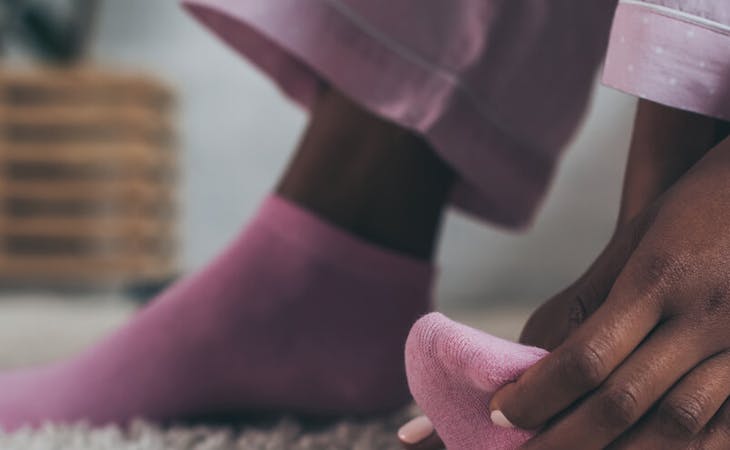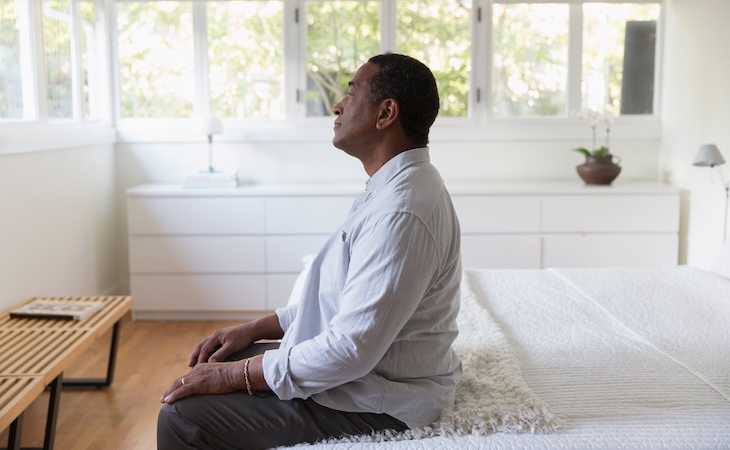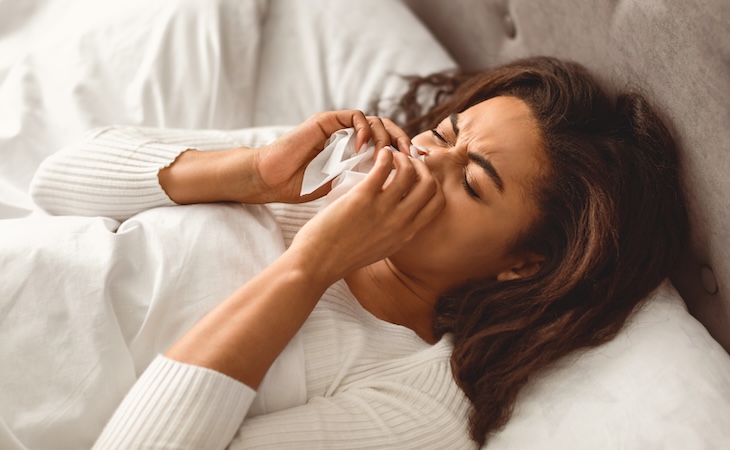Most folks normally take their socks off before getting in bed—but what if we told you leaving them on could get you 37 more minutes of sleep a night? Considering that 25% of Americans suffer from sleep disorders, we need every second of sleep we can get. And it turns out tht sleeping with socks on just might be the answer to getting more Z’s.
A recent study from the Journal of Physiological Anthropology suggests that you don’t need high-thread-count bedding or blackout window treatments to improve your rest. All you need to get a better night’s sleep—or more specifically, more than a half hour’s worth of extra sleep—is a pair of socks.
It makes sense on some kind of anecdotal level: the cozier you are at bedtime, the cozier you’ll stay. But now there is actual science behind that cause and effect.
Does sleeping with socks on help you sleep?
“Have you ever gotten so hot at night that you stick your foot out from under the covers and instantly you feel better?” asks sleep expert Michael Breus, PhD. “The reason that happens is because we don’t have any hair on the bottom of our feet, and so that allows our blood vessels to vasodilate and move heat away.”
The opposite is also true, he says, meaning that if you cover your feet, you’ll get warmer and feel better in the long run. This new study looked at people who had a hard time falling asleep because on some level their extremities were cold, even if they weren’t aware of it. (Have you ever touched your partner with your foot in bed, and they let you know that your foot is ice cold? That’s what we’re talking about.)
“When your heart is pumping, it pumps blood out,” Breus says, “but not to your extremities, like your fingertips. Wearing socks creates an environment where blood actually makes it all the way to your extremities, and you can fall asleep.” So one of the benefits of wearing socks to bed is that it helps regulate your temperature for an easier time falling asleep.
Chris Brantner, certified sleep science coach with SleepZoo.com, explains that your core temperature rises and lowers in line with your circadian rhythm. It’s higher during the day to make you feel energized and lower at night to help you achieve a relaxed and rested state. In essence, socks help redistribute heat throughout your body and regulate your body temperature, which is necessary for a good night’s sleep.
Sleeping in socks: looking at the research
For this new study, the researchers set out to evaluate the effect of feet warming on sleep quality and thermoregulatory responses during sleep. In other words, they were looking for proof that with socks on, you would fall asleep faster, stay asleep longer, and your overall sleep would be more efficient.
They concentrated their study on these four areas:
- How quickly somebody falls asleep: What they found was that when wearing socks, people fell asleep about seven and a half minutes faster.
- Total sleep time: The number of minutes people spent asleep when their feet were warm—as opposed to when they weren’t warm—actually increased by about 37 minutes.
- The number of awakenings: The number of times a person woke up during the night was more than seven times less when participants slept in socks.
- The sleep-efficiency statistic: This SES is calculated by dividing the number of minutes spent asleep by the number of minutes of the entire sleep period. In this study, the sleep-efficiency statistic rose more than 7% higher in those wearing socks to bed.
Should everyone wear socks to bed?
While all of the new research is promising for someone who wants a better night’s sleep, sleeping with socks on might not be the right solution for a woman going through menopause. In fact, that’s the one time when socks in bed may have a negative impact on sleep.
According to Harvard Health, the vasomotor symptoms of menopause—such as heat in the face and chest, flushing, perspiration, and a drenching sweat when you’re in bed— make it almost impossible to sleep.
So when Breus has a patient going through menopause, he tells her to do everything she can to avoid heat at night. “If she is going through hot flashes, we’re trying to get her as cool as possible,” he says. “The only time I’d still recommend socks is if she has poor circulation.”
Brantner concurs: “Sleeping with socks might be unbearable,” he says. However, there are other things you can do to keep cool at night if you’re in menopause, like turning the AC down, or using a cooling mattress pad. (Here are more tips on how to sleep cool.)
Beyond socks for a better night’s sleep
So you’ve put the socks on, and you’re ready for your scientifically proven good night’s sleep. But what else can you do to promote better slumber? Brantner acknowledges that good sleep hygiene is complicated. “There’s the need to drop the temperature,” he says. “There’s the need to block out light and noise. There’s the need to set a consistent sleep and wake schedule.”
Fortunately, simple measures can go a long way there too. A sleep mask is great for blocking unwanted light and can help you fall asleep faster. Similarly, white noise has been scientifically shown to improve sleep quantity and quality. (For tips on how to maximize your sleep environment, check out these strategies used by luxury hotels, and learn how to re-create them in your own home.)
And while you’re at it, consider letting those socks do double duty while they help you sleep. After all, you multitask during the day, so why not overnight? To wake up to smoother feet, apply moisturizing lotion before putting on your sleep socks. Or you can buy special socks made for this purpose, like Bliss Softening Socks, which have a gel lining that contains olive, grape-seed and jojoba oils.
Take our poll: Do you sleep with or without a top sheet?




